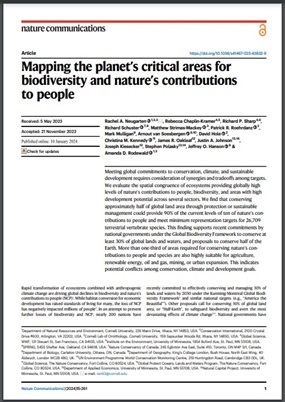
Meeting global commitments to conservation, climate, and sustainable development requires consideration of synergies and tradeoffs among targets. We evaluate the spatial congruence of ecosystems providing globally high levels of nature’s contributions to people, biodiversity, and areas with high development potential across several sectors. We find that conserving approximately half of global land area through protection or sustainable management could provide 90% of the current levels of ten of nature’s contributions to people and meet minimum representation targets for 26,709 terrestrial vertebrate species. This finding supports recent commitments by national governments under the Global Biodiversity Framework to conserve at least 30% of global lands and waters, and proposals to conserve half of the Earth. More than one-third of areas required for conserving nature’s contributions to people and species are also highly suitable for agriculture, renewable energy, oil and gas, mining, or urban expansion. This indicates potential conflicts among conservation, climate and development goals.






